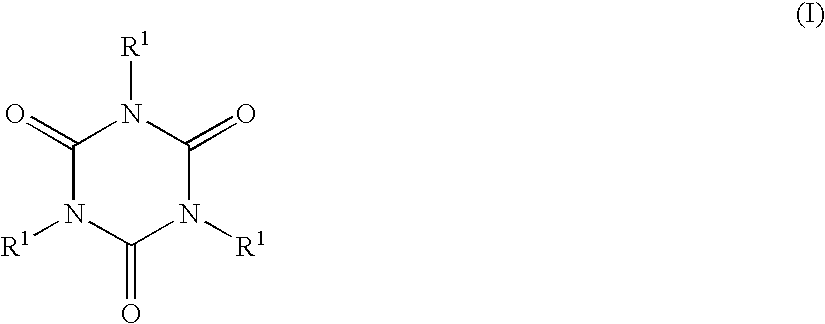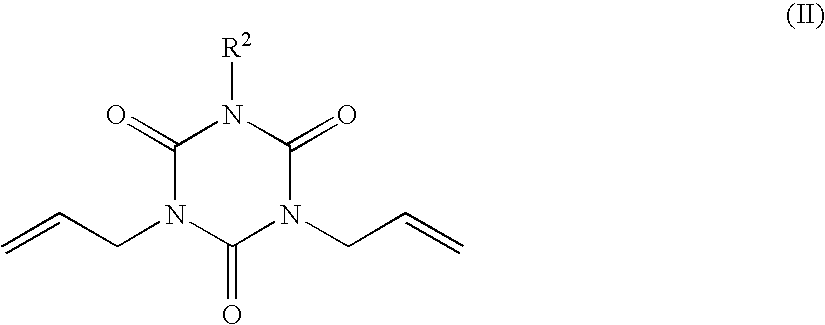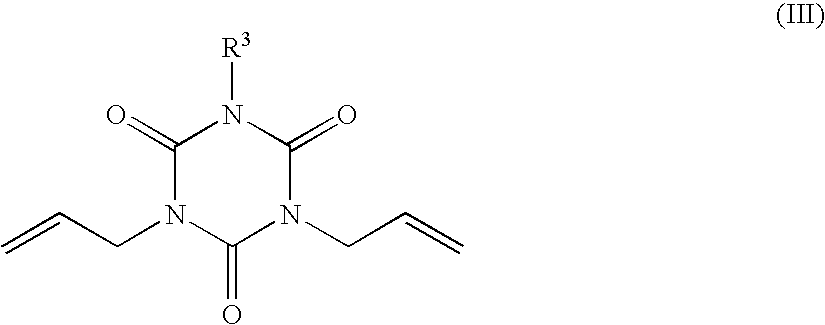Hardenable composition, hardening product, process for producing the same and light emitting diode sealed with the hardening product
a technology of hardening product and composition, which is applied in the field of curing product and curing composition, can solve the problems of low toughness of sealant resin, low adhesion properties, and low credibility of final products, and achieve excellent adhesion properties, high transparency, and excellent adhesion properties
- Summary
- Abstract
- Description
- Claims
- Application Information
AI Technical Summary
Benefits of technology
Problems solved by technology
Method used
Image
Examples
synthesis example 1
(Synthesis Example 1)
[0422] A 5-L separable flask was charged with 1.8 kg of toluene and 1.44 kg of 1,3,5,7-tetramethylcyclotetrasiloxane, and heated until the inside temperature arrived at 104° C. Thereto was added dropwise a mixture of 200 g of triallyl isocyanurate, 1.44 mL of platinum-vinylsiloxane complex solution in xylene (containing 3% by weight of platinum) and 200 g of toluene. The resulting mixture was heated under reflux in an oil bath at 120° C. for 7 hours. Then, 1.7 g of 1-ethynyl-1-cyclohexanol was added. The unreacted portion of 1,3,5,7-tetramethylcyclotetrasiloxane and the toluene were distilled off under reduced pressure. 1H-NMR revealed that the product was the reaction product resulting from part of the SiH groups of 1,3,5,7-tetramethylcyclotetrasiloxane with triallyl isocyanurate (hereinafter referred to as partial reaction product B1, SiH value: 8.2 mmol / g, allyl value: 0.12 mmol / g) The product is a mixture but contains, as a main component, the compound havin...
example 1
(Measurement Example 1)
[0426] The one-pot mixtures prepared in Example 1, and Comparative Examples 1 and 2 were applied on an aluminum plate (A-1050P) to prepare coating films of approximately 20 μm, and the films were heated at 120° C. for 1 hour. The optical materials were colorless and transparent. After cooling the films to room temperature, adhesion property test was carried out according to JISK 5400 cross-cut taping method (25 grids of 2 mm square) The obtained results are shown in Table 1.
(Measurement Example 2)
[0427] For the curing products obtained in Example 1, and Comparative Examples 1 and 2, a heat and light resistance test was carried out using Suga Test Instruments' M6T-type metering weatherometer (black panel temperature 120° C., irradiation intensity: 50 MJ / m2), and coloration and the light transmittance at 470 nm using a spectrophotometer (U-3300, Hitachi, Ltd.) were determined before and after the test. The obtained results are shown in Table 1.
TABLE 1Example...
example 2
(Example 2)
[0429] The sheet-shaped curing product produced in Example 1 is cut into an appropriate form, and fixed on a light-transmitting window disposed on a metal cap for can type. Meanwhile, a light emitting element having a double-hetero structure in which an Si- and Zn-doped InGaN active layer formed on a sapphire substrate by MOCVD (Metal Organic Chemical Vapor Deposition) method being sandwiched with n- and p-type AlGaN clad layers is prepared. Successively, this light emitting element is mounted on a metal stem for can type, and p- and n-electrodes were wire-bonded with an Au line to the respective leads. This is air-sealed with the above metal cap for can type. In this manner, a can type light-emitting diode can be produced.
(Example 3)
[0430] On a washed sapphire substrate, by MOCVD (Metal Organic Chemical Vapor Deposition) method, the below-mentioned layers are laminated in the following order: n-type GaN layer which is an undoped nitride semiconductor; GaN layer which i...
PUM
| Property | Measurement | Unit |
|---|---|---|
| Fraction | aaaaa | aaaaa |
| Fraction | aaaaa | aaaaa |
| Percent by mass | aaaaa | aaaaa |
Abstract
Description
Claims
Application Information
 Login to View More
Login to View More - R&D
- Intellectual Property
- Life Sciences
- Materials
- Tech Scout
- Unparalleled Data Quality
- Higher Quality Content
- 60% Fewer Hallucinations
Browse by: Latest US Patents, China's latest patents, Technical Efficacy Thesaurus, Application Domain, Technology Topic, Popular Technical Reports.
© 2025 PatSnap. All rights reserved.Legal|Privacy policy|Modern Slavery Act Transparency Statement|Sitemap|About US| Contact US: help@patsnap.com



